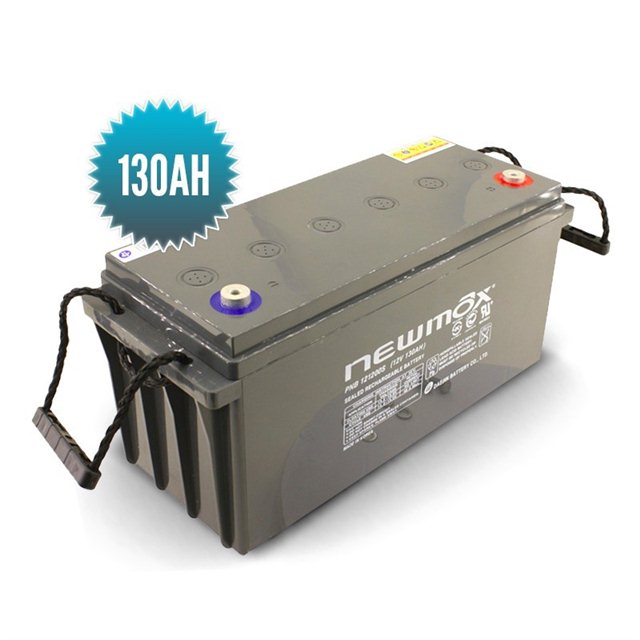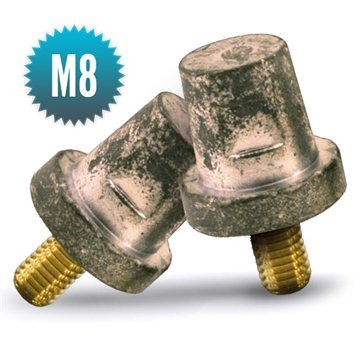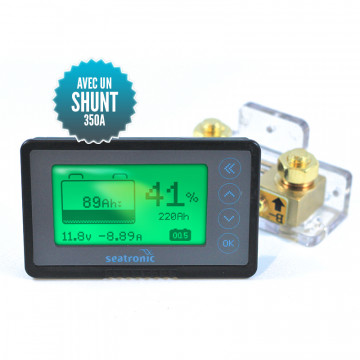

 CATALOG AND PRICE LIST
CATALOG AND PRICE LIST
 ENERGY
ENERGY
 COMPUTER SCIENCE
COMPUTER SCIENCE
 INSTALLERS
INSTALLERS
 BLOG CONSEIL
BLOG CONSEIL





NEWMAX gel batteries are generally the most suitable for use as service batteries, thanks to their gelled electrolyte and thick electrodes, they resist an impressive number of charge/discharge cycles and their full rated capacity is available.
| Function | Service batteries (excellent cycling performance and greatly reduced risk of sulfation). VRLA technology ensures watertightness (avoids any risk of acid leakage and hydrogen dissipation (except in extreme cases)). The hybrid technology developed by Newmax with glass fiber separators (AGM) ensures very good performance in terms of charge and discharge speed. |
|---|---|
| Technology | VRLA (Valve Regulated Lead Acid) gel electrolyte with AGM (Absorptive Glass Mat) separator and flat plates. |
| Electrodes | High density anti corrosive lead (99.99% pure lead) / calcium. |
| Voltage / Capacity | 12V - 130 Ah |
| Cycling performance | 500 cycles at 100% discharge, 950 cycles at 80% and 2000 cycles at 50%. |
| Capacity C20 - C10 | 130 Ah - 120 Ah |
| CCA | 800A |
| Floating life | 10 years at 25°C |
| Charging voltage at 25°C | Absorption: 14.4V - 14.6V / Maintenance: 13.3V to 13.6V |
| Temperature correction | 3.3V per 10 degrees (the higher the temperature, the lower the charge voltage) |
| Charging current | 30% of the nominal capacity. Note that this charge current regulates itself naturally when the absorption voltage is reached. When the batteries are used in deep discharge and the charge source is large compared to the capacity of the battery bank, it is recommended to install regulation systems with temperature sensors to adjust the absorption voltage. |
| Self-discharge | < 2% per month at 25 degrees. If not used, a recharge is recommended every six months. |
| Operating temperature | -20°C to 50°C |
| Dimensions | 443*167*204 mm |
| Weight | 41 kg |
| Terminal block | Copper nickel silver plated brass insert M8 |
| Warranty | 2 years |
Newmax VRLA (Valve Regulated Lead Acid) Gel batteries are state of the art and offer a level of performance that is recognized worldwide.
Newmax batteries are the result of 20 years of experience and research and development in the field of service and industrial batteries. These gel batteries are manufactured according to the international standards ISO 9001 and ISO 14001 which guarantees their quality and durability. Newmax gel batteries will allow you to have a reliable and efficient energy reserve on board adapted to your use. The range extends from 12V-65Ah to 12V-220Ah.
The Newmax gel batteries have a hybrid technology (glass fiber separator) allowing to improve significantly their performances in fast charge/discharge. For more information, you can consult our product sheet which describes these batteries in a more exhaustive way.
The gel technology used for NEWMAX batteries allows to reduce significantly the sulphation phenomenon which is the main cause of battery wear.
NEWMAX gel batteries also use VRLA (Valve Regulated Lead Acid) technology, which ensures gas recombination during battery recharging (no maintenance is required) while providing safety in the event of overcharging due to a charging device failure. No maintenance is required during the life of the battery.
NEWMAX gel batteries are best suited for use as service batteries. Thanks to their gel electrolyte and thick electrodes, they resist an impressive number of charge/discharge cycles and their full rated capacity is available.
Characteristic values: 500 cycles at 100%, 950 cycles at 80% and 2000 cycles at 50% discharge
An advantage of gel batteries that is not shown in the graph above is the possibility to leave the battery discharged for a short period of time without causing irreversible damage. It should be noted, however, that regardless of the type of technology, it is recommended to recharge the batteries as soon as possible after discharge.
Thanks to the quality of construction and the purity of the materials used, the self-discharge of NEWMAX gel batteries is very limited. At 25 degrees, the characteristic discharge rate is limited to 2% per month.
NEWMAX gel batteries are generally the most suitable for use as service batteries, thanks to their gelled electrolyte and thick electrodes, they resist an impressive number of charge/discharge cycles and their full rated capacity is available.
| Function | Service batteries (excellent cycling performance and greatly reduced risk of sulfation). VRLA technology ensures watertightness (avoids any risk of acid leakage and hydrogen dissipation (except in extreme cases)). The hybrid technology developed by Newmax with glass fiber separators (AGM) ensures very good performance in terms of charge and discharge speed. |
|---|---|
| Technology | VRLA (Valve Regulated Lead Acid) gel electrolyte with AGM (Absorptive Glass Mat) separator and flat plates. |
| Electrodes | High density anti corrosive lead (99.99% pure lead) / calcium. |
| Voltage / Capacity | 12V - 130 Ah |
| Cycling performance | 500 cycles at 100% discharge, 950 cycles at 80% and 2000 cycles at 50%. |
| Capacity C20 - C10 | 130 Ah - 120 Ah |
| CCA | 800A |
| Floating life | 10 years at 25°C |
| Charging voltage at 25°C | Absorption: 14.4V - 14.6V / Maintenance: 13.3V to 13.6V |
| Temperature correction | 3.3V per 10 degrees (the higher the temperature, the lower the charge voltage) |
| Charging current | 30% of the nominal capacity. Note that this charge current regulates itself naturally when the absorption voltage is reached. When the batteries are used in deep discharge and the charge source is large compared to the capacity of the battery bank, it is recommended to install regulation systems with temperature sensors to adjust the absorption voltage. |
| Self-discharge | < 2% per month at 25 degrees. If not used, a recharge is recommended every six months. |
| Operating temperature | -20°C to 50°C |
| Dimensions | 443*167*204 mm |
| Weight | 41 kg |
| Terminal block | Copper nickel silver plated brass insert M8 |
| Warranty | 2 years |
Newmax VRLA (Valve Regulated Lead Acid) Gel batteries are state of the art and offer a level of performance that is recognized worldwide.
Newmax batteries are the result of 20 years of experience and research and development in the field of service and industrial batteries. These gel batteries are manufactured according to the international standards ISO 9001 and ISO 14001 which guarantees their quality and durability. Newmax gel batteries will allow you to have a reliable and efficient energy reserve on board adapted to your use. The range extends from 12V-65Ah to 12V-220Ah.
The Newmax gel batteries have a hybrid technology (glass fiber separator) allowing to improve significantly their performances in fast charge/discharge. For more information, you can consult our product sheet which describes these batteries in a more exhaustive way.
The gel technology used for NEWMAX batteries allows to reduce significantly the sulphation phenomenon which is the main cause of battery wear.
NEWMAX gel batteries also use VRLA (Valve Regulated Lead Acid) technology, which ensures gas recombination during battery recharging (no maintenance is required) while providing safety in the event of overcharging due to a charging device failure. No maintenance is required during the life of the battery.
NEWMAX gel batteries are best suited for use as service batteries. Thanks to their gel electrolyte and thick electrodes, they resist an impressive number of charge/discharge cycles and their full rated capacity is available.
Characteristic values: 500 cycles at 100%, 950 cycles at 80% and 2000 cycles at 50% discharge
An advantage of gel batteries that is not shown in the graph above is the possibility to leave the battery discharged for a short period of time without causing irreversible damage. It should be noted, however, that regardless of the type of technology, it is recommended to recharge the batteries as soon as possible after discharge.
Thanks to the quality of construction and the purity of the materials used, the self-discharge of NEWMAX gel batteries is very limited. At 25 degrees, the characteristic discharge rate is limited to 2% per month.
NEWMAX gel batteries are generally the most suitable for use as service batteries, thanks to their gelled electrolyte and thick electrodes, they resist an impressive number of charge/discharge cycles and their full rated capacity is available.
| Function | Service batteries (excellent cycling performance and greatly reduced risk of sulfation). VRLA technology ensures watertightness (avoids any risk of acid leakage and hydrogen dissipation (except in extreme cases)). The hybrid technology developed by Newmax with glass fiber separators (AGM) ensures very good performance in terms of charge and discharge speed. |
|---|---|
| Technology | VRLA (Valve Regulated Lead Acid) gel electrolyte with AGM (Absorptive Glass Mat) separator and flat plates. |
| Electrodes | High density anti corrosive lead (99.99% pure lead) / calcium. |
| Voltage / Capacity | 12V - 130 Ah |
| Cycling performance | 500 cycles at 100% discharge, 950 cycles at 80% and 2000 cycles at 50%. |
| Capacity C20 - C10 | 130 Ah - 120 Ah |
| CCA | 800A |
| Floating life | 10 years at 25°C |
| Charging voltage at 25°C | Absorption: 14.4V - 14.6V / Maintenance: 13.3V to 13.6V |
| Temperature correction | 3.3V per 10 degrees (the higher the temperature, the lower the charge voltage) |
| Charging current | 30% of the nominal capacity. Note that this charge current regulates itself naturally when the absorption voltage is reached. When the batteries are used in deep discharge and the charge source is large compared to the capacity of the battery bank, it is recommended to install regulation systems with temperature sensors to adjust the absorption voltage. |
| Self-discharge | < 2% per month at 25 degrees. If not used, a recharge is recommended every six months. |
| Operating temperature | -20°C to 50°C |
| Dimensions | 443*167*204 mm |
| Weight | 41 kg |
| Terminal block | Copper nickel silver plated brass insert M8 |
| Warranty | 2 years |
Newmax VRLA (Valve Regulated Lead Acid) Gel batteries are state of the art and offer a level of performance that is recognized worldwide.
Newmax batteries are the result of 20 years of experience and research and development in the field of service and industrial batteries. These gel batteries are manufactured according to the international standards ISO 9001 and ISO 14001 which guarantees their quality and durability. Newmax gel batteries will allow you to have a reliable and efficient energy reserve on board adapted to your use. The range extends from 12V-65Ah to 12V-220Ah.
The Newmax gel batteries have a hybrid technology (glass fiber separator) allowing to improve significantly their performances in fast charge/discharge. For more information, you can consult our product sheet which describes these batteries in a more exhaustive way.
The gel technology used for NEWMAX batteries allows to reduce significantly the sulphation phenomenon which is the main cause of battery wear.
NEWMAX gel batteries also use VRLA (Valve Regulated Lead Acid) technology, which ensures gas recombination during battery recharging (no maintenance is required) while providing safety in the event of overcharging due to a charging device failure. No maintenance is required during the life of the battery.
NEWMAX gel batteries are best suited for use as service batteries. Thanks to their gel electrolyte and thick electrodes, they resist an impressive number of charge/discharge cycles and their full rated capacity is available.
Characteristic values: 500 cycles at 100%, 950 cycles at 80% and 2000 cycles at 50% discharge
An advantage of gel batteries that is not shown in the graph above is the possibility to leave the battery discharged for a short period of time without causing irreversible damage. It should be noted, however, that regardless of the type of technology, it is recommended to recharge the batteries as soon as possible after discharge.
Thanks to the quality of construction and the purity of the materials used, the self-discharge of NEWMAX gel batteries is very limited. At 25 degrees, the characteristic discharge rate is limited to 2% per month.
Sur notre blog conseil, découvrez les performances exceptionnelles des batteries Newmax gel en décharge profonde.



